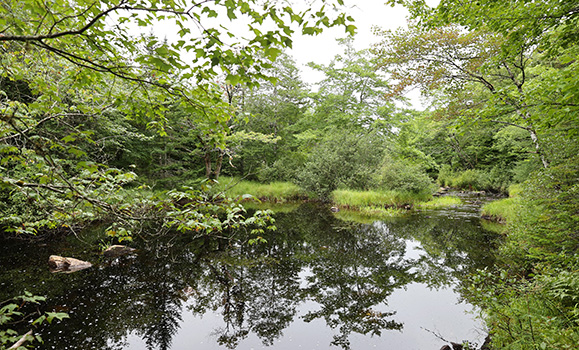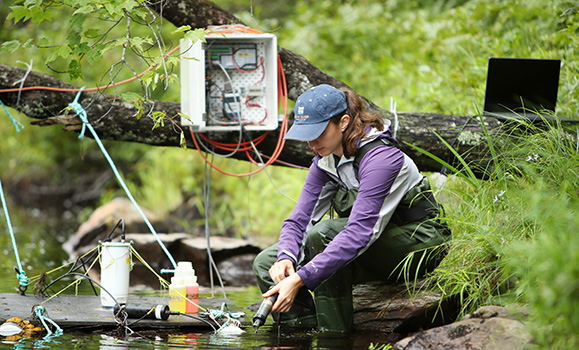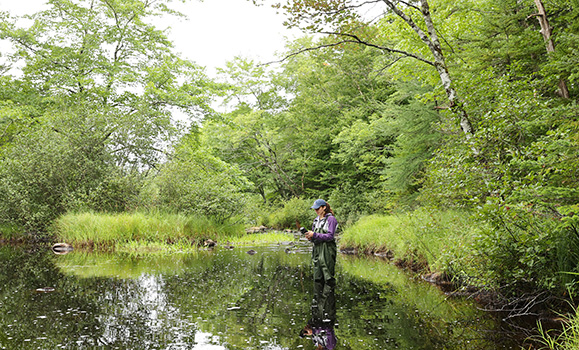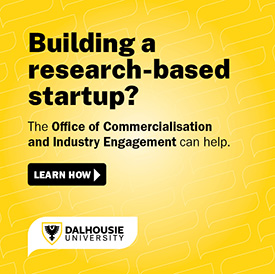The Snapshot
While pursuing research aimed to restore Nova Scotia salmon habitats, ������̳ hydrologist Dr. Shannon Sterling and Dal alum Dr. Edmund Halfyard stumbled into the forefront of carbon dioxide (CO2) removal science and growing market demand to remove the gas from the atmosphere. The discovery led to her current role as founder and chief science officer of , a promising CO2��removal startup attracting investment from global players.
The Idea
Drs. Sterling and Halfyard had been working for years trying to save what remains of Nova Scotia’s wild salmon stocks by studying a process that combats the acidification of the province’s rivers.
 Nova Scotia river where Dr. Sterling and her team study carbon dioxide removal.��
Nova Scotia river where Dr. Sterling and her team study carbon dioxide removal.��
Following restoration techniques established in Scandinavia to counteract the impacts of acid rain, the has pursued a program of adding crushed limestone to rivers and the forests that drain into them. Dr. Sterling collaborated with the charitable organization and its former lead scientist Dr. Halfyard to study the process and how its introduction of alkalinity to the waterways can help fish flourish.
A noble pursuit, but Dr. Sterling discovered that there was as much good happening above the waterline as there was for fish in the river. The a-ha moment came in 2018, when she started reading scientific papers focused on the urgent need to remove CO2 from the atmosphere.��
“It was the IPCC Paris Agreement where the world community got together and collectively said ‘Okay, we’ve really screwed up. Even if we meet all our CO2 emissions reduction targets, we're still going to overshoot by 1.5 degrees of warming. We have to draw down carbon from the atmosphere,’” says Dr. Sterling.
Emerging studies showed that adding��alkaline materials such as limestone to the Earth’s surface had the potential to enhance the absorption of CO2 from the air.��
“We’ve been doing that in watersheds for years,” thought Dr. Sterling, who felt slightly dizzied by the realization that her ecosytem research might serendipitously make her a player in the emerging global movement to remove atmospheric CO2.
The Challenge
“The scariest thing we faced was building a whole new pathway,” she says. “We were making quite a large claim. There was ocean alkalinity enhancement as a CO2 removal strategy. And enhanced weathering on land. But we were proposing this whole new new class of CO2 removal for rivers.”
 ������̳ graduate student tests river water.
������̳ graduate student tests river water.
To start getting the idea on the radar of the global climate mitigation community, she reached out to one of the leaders in the space, Dr. David Beerling at the University of Sheffield. The founder and director of the , had received a large grant following the Paris Agreement to study how spreading crushed rocks on soils could “hack” the long-term carbon cycle.
“So, I called David and said, ‘You know, we're already putting crushed rock on soils and in rivers in our work with salmon. Maybe there is a CO2 removal component to what we are doing you’d like to consider,’” she says.��
Excited by the opportunity to see similar work in action, he came to observe Dr. Sterling and her colleagues’ field studies spreading limestone on forest floors via helecopter. While she was encouraged by Dr. Beerling’s interest in their land-based work, she couldn’t help her attention flowing back to the potential of river-based methods.
“I was thinking rivers could actually give us similar result with the added advantage of increased control and speed,” she says. “We've been monitoring the effects of adding limestore to land and you don’t get results for a few years, so there’s potentially years delay in the impact. With rivers, you can quickly test if you don't have the right dose and can change it.”
The Solution
She set out to investigate her theory with Dr. Halfyard. But to move the science forward, the pair needed monitor reactions at the water’s surface to observe if CO2 was being absorbed. It would take complex and expensive fieldwork.

A lab on the side of the riverbank.
That’s when Dr. Sterling got a lifeline from a Toronto philanthropist turned on to her work by Dr. Beerling who, in yet another fortunate twist of fate, had just returned from his visit to Nova Scotia.
“They funded our monitoring, and we started measuring changes to the carbonate system in rivers where limestone dosers were being employed.” The results were impressive, she says, “It was like, wow, this is actually working really well.”
When Dr. Sterling looked out into the world, she couldn’t find anyone else doing what she was doing. CO2 removal researchers were focused on the ocean and land, but not rivers. She realized that her discovery could comprise intellectual property for a new carbon credits business venture while also advancing her goals to restore acidified river habitats. And so, with Dr. Halfyard and Luke Connell, who is now CEO, as her cofounders, was born.

������̳ alumnus Dr. Edmund Halfyard, CarbonRun’s Chief Tech Officer. (Photo provided)
She turned to ������̳’s Office of Commercialization and Industry Engagement for advice on how to build the company grounded in university research. She was concerned about pursuing studies that serve both her roles as an academic and entrepreneur.
“They were able to point out where conflicts could occur. Just knowing where the problems might be ahead of time was extremely helpful. University-industry relationships can go wrong, but they can also go really, really right when executed properly,” she said.
The Impact
Using standards defined by the to identify successful carbon removal startups, Dr. Sterling worked hard to validate the impact of her approach. “They established criteria and we started ticking them off one by one – cost, community engagement, feedstock, CO2 uptake – tick, tick, tick,” she says.
And, because there are more than 50 years of research focused on adding limestone to rivers for habitat restoration, she says there is significant data demonstrating safety and ecosystem benefits.
 ��
��
Taking readings.
CarbonRun is currently quantifying the carbon drawdown of two limestone dosers operated by the Nova Scotia Salmon Association. The dosers use solar and wind power and passively take in river water, mix it with limestone and then return it to the river. Currents then weather the mineral, creating the reaction that allows it to capture CO₂ and convert it to a stable bicarbonate. Then it’s off to the ocean for permanent storage.
The strength of CarbonRun’s science has attracted major global attention, including the Frontier Carbon Removal Fund which was founded by companies like Google, Meta, and Shopify. Frontier made an “advance market commitment”, a pre-purchase of carbon credits to provide both a vote of confidence and a financial boost to advance and scale CarbonRun’s research and operations.
It’s a very heady time for the researcher, who just three years ago had no plans to pursue ��entrepreneurship. The company has been welcomed into , Invest Nova Scotia’s state-of-the-art facility geared to helping science-based startups build their enterprises. And she is working closely with communities in the province to establish new sites for limestone dosing.
Partnerships are paramount she says, noting that community collaboration and comfort are essential to moving forward. CarbonRun’s projects will bring ecosystem restoration, employment and other economic benefits Dr. Sterling says, all of which will be important to communicate to communities surrounding potential new dosing sites.

The hunt is now on to find the ideal locations. It’s important that sites are close to limestone deposits to lessen fossil fuels used to deliver the minerals to the site – a key variable to consider when CO2 removal is the essence of your enterprise. Factors like river size, velocity, chemistry, and proximity to the ocean are also important, but most important are the considerations of the aquatic ecosystems and the communities around each river.
“It's a Goldilocks approach,” she says. “We need to find communities to partner with and rivers that are just right."


